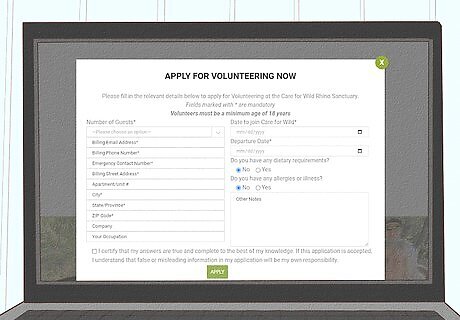
views
Applying to Volunteer

Contact your local animal shelter or humane society. The organization may have a contact person or "volunteer coordinator" who can help you get involved at their facility. Visit a shelter's website, and check for any information that is listed for volunteers. Some shelters will not offer much information on their websites, and some may not have websites at all. Volunteers that are currently involved or were involved in the past can also share a lot of useful information. Look online for shelters near your home or office. Consider the distance from your home, the type of animal, and the needs of a given shelter. If two animal shelters are right next to each other, but one of them is in more urgent need of volunteers: it may be best to choose that shelter. Find out what manners, tools and processes are used in a given shelter, what their yards and setups look like, how animals are socialized and interacted with, and so on.

Visit the shelter and ask about volunteering. Call, visit their website, or visit the shelter in person. See what the atmosphere is like, and observe how healthy and happy the animals seem to be. If you still think that this is the right place for you, ask for an application to be a volunteer. Most shelters will give you a form to fill out, along with a list of basic guidelines. Don't be shy! Ask the staff any questions you have about volunteering. If possible, talk directly to the owner or an employee of the shelter. An employee or current volunteer will usually reach out to the owner for you if he/she isn't available when you're around.

Fill out an application. This may be a physical form, or it may be online. You may need to provide a birth certificate and photo ID. Fill out the application carefully and truthfully, and make sure that all of your information is correct. You may have to complete a criminal background check. Shelters want to make sure that their volunteers are trustworthy people. Look for a phone number if you can't find an application. Call the shelter and ask whether they are looking for volunteers. Alternately: simply visit the shelter in person when you have a free afternoon.

Understand the volunteer requirements. Different shelters have different requirements, which often depend on the specific work that you'll be doing. If you want to directly handle animals, it helps to have prior experience with animals. As a general rule, you must: Be at least 16 (sometimes 18) years of age. If you are under that age, some shelters run family volunteer programs where parents and children come in to work together. Check in with several shelters. If you aren't old enough to volunteer at one center, you might be old enough to volunteer at another. Be able to commit to a long-term volunteer position. Some shelters require a commitment as long as a year, so that they know it's worth their time to train you. Many shelters require a minimum of one regularly-scheduled shift every other week. Shifts may run for two hours or longer, depending on how much work needs to be done. Be able to fulfill the physical duties. Most volunteer roles require that you are able to stand or walk for up to 3 hours. You should be able to lift 20 or more pounds. Be able to hear, see, and interpret animal behavior and body language. This is most important if you'll be working directly with animals. Be able to keep a positive attitude. It can be hard to emotionally handle a stressful workplace.

Attend the training session. Many shelters have a training session for new volunteers before they can officially start. This usually includes a tour of the facility, instructions on the jobs you will be doing, meeting staff, etc. Depending on the shelter, you might have to RSVP for a group training session that they hold once a month. Other shelters will train you whenever you can be available. Ask the shelter staff for more information. Do anything else that the shelter says you need to do before starting. For example, you may need to vaccinate yourself against common animal-transmitted diseases.

Find a schedule that works well for you. Perhaps you can volunteer after work or school, or on weekends in the mornings or afternoons. The owner of the shelter will usually tell you what you can do at the certain scheduled time: bathing the animals, socializing them, feeding them, etc. Some shelters have designated "shifts" for volunteers, whereas others just let helpers drop in when they have time. Some shelters only allow a certain amount of volunteers at a time. Ask the staff which days and time slots are available and find one that fits in with your schedule.

Get onto a waiting list. Don't be discouraged if the owner tells you that s/he doesn't need any volunteers at the moment. Don't give up if there isn't an available time slot that works for you. Ask the shelter to put you on a volunteer waiting list. Once you're on this list, they may call you and ask you to help out once something opens up.
Finding the Right Shelter

Consider which animals you want to work with. Most shelters take in dogs and cats, but you may be hard-pressed to find a center that deals with more exotic pets. You may be able to choose between working with dogs and cats, or you may be asked to deal with both. Bear in mind that you may not even be allowed to work with the animals at first. You often need to work at the shelter for a while before you can handle animals directly.

Learn about the available volunteer positions. Depending on the shelter, you may be assigned to a specific job, or you may perform various tasks as need arises. You may be required to complete a certain number of hours of support tasks before you are allowed to work directly with animals. Laundry, dish-washing, floor-mopping, and office work are often necessary to keep a shelter running smoothly. Ask about volunteer programs on- and off-site. Most shelters need people to help in the facility: walking dogs, handling cats, and grooming various animals. However, many shelters also have off-site adoption events or fundraisers with which you might be able to help. If you have any special skills that relate to shelter work: tell the shelter! Volunteers can provide website support, offer legal aid, donate medical services, photograph adoptable animals for the adoption websites, or even create and donate original art for sale to benefit the shelter.

Make sure that volunteering will fit with your schedule. Most volunteer opportunities occur during a shelter's open hours, although you might also be asked to care for animals and do maintenance work during the off-hours. Shelters are usually open seven days a week, with slightly fewer hours on Saturdays and Sundays.
Being a Volunteer

Prepare to volunteer. You may need to provide your own lunch. Dress appropriately for the weather if you'll be working outdoors. Consider bringing tennis shoes or rubber boots, depending upon your chores. You shouldn't wear shiny jewelry or baubles, because you don't want the animals taking them, breaking them, or fighting you for them. It's also a good idea to bring bandages, peroxide, and disinfectant cream.

Represent your shelter. Some people believe that animals in shelters are unwanted or undesirable in some way. One of the most beneficial things you can do is to share the positive facts about your shelter with people, especially those who have never adopted a pet before. By helping to change the mindset of the public, you can help more animals find their "forever homes."

Donate. If you can't afford to spend much time volunteering at a shelter, you can still help out by donating money and animal-care items. Shelters need food, toys, bedding, and grooming items for each of the animals that come into their care. Most shelters will be happy to accept donations of used items. Ask for a list of things that they need. Some of these items may include: Pet food, pet treats, feeding items, and bowls. Blankets, towels, or padding or bedding for cages. Try going to a local hotel and asking them for their stained linens. Disinfectants, grooming items, and newspaper for puppy training and cleaning. Toys, scratching posts, balls, and toys.

Think about fostering an animal. When you foster an animal, you are committing to take it into your home and to care for it. It is your job to help it get healthy and socialized before it is placed for adoption. Make sure that you have room for a temporary dog or cat in your home, and ask yourself whether you have the energy to care for this animal. If so, ask whether the shelter has a foster program. This is a big responsibility, but it can be deeply rewarding.




















Comments
0 comment